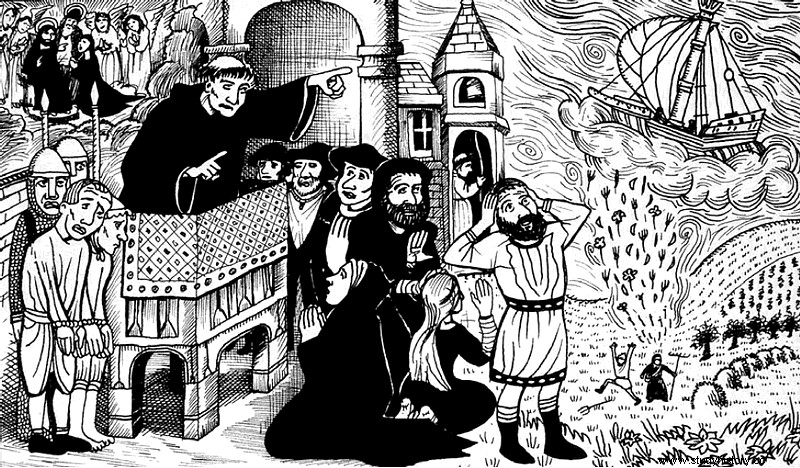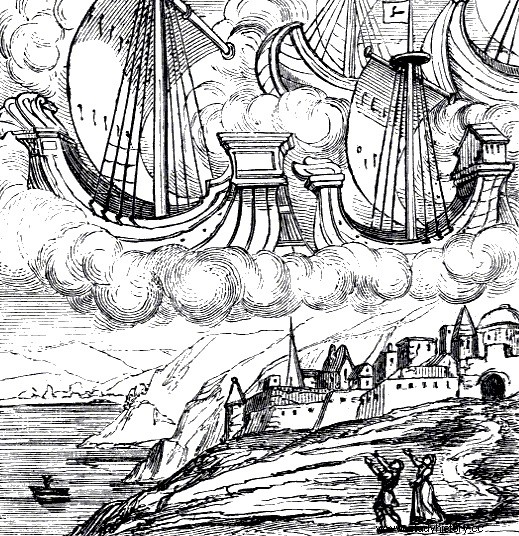Fighting against popular terrors, well anchored in the collective imagination, is almost in the realm of the impossible. They are all the more harmful as the risk of civil disorder, or even murder, within a rural population remains a well-founded concern. Yet this is what the Bishop of Lyon, Monsignor Agobard, tried to do in the 9th century. But while writing his text, De grandine et tonitruis (Hail and thunder), he would never have thought that his account would turn into proof of the existence of a passage of UFOs.

So what really happened?
We have to go back a few centuries earlier, to the time of ancient Rome. In 319 AD, the Roman Emperor Constantine authorized rural mages, the stormers , to command the elements and more specifically to cause hail to fall in the neighbour's field in exchange for financial compensation. A lucrative business. Of course, this authorization was self-evident as long as the agricultural production of the State, where heavy taxes were levied, was not affected. It took several more long centuries before the king of the Visigoths, in 506, decreed the death penalty against these improvised magicians who looked like extortionists.
A popular runaway in the Rhone Valley was going to be the drop of water too much for the Bishop of Lyon. At that time, the existence of Magonia (in other words the land of the mages) was not eccentric and pushed the inhabitants, peasants for the most part, to worry about a dangerous pact between the stormers and the sorcerers of Magonia, the Magonians . It was said of the latter that they appeared on “flying boats” to recover the hard harvest of the people, and it is all the more true that we would have seen several men and a woman fallen from an aircraft!
Here is an excerpt from Agonard's story, Of Hail and Thunder (1841 edition with Latin translation):
“We have seen and heard many people foolish enough and blind enough to believe and to affirm that there is a certain region called Magonia, whence depart, sailing on the clouds, ships which transport, in this same country, the fruits felled by hail and destroyed by the storm, after, however, the value of the corn and other fruits has been paid by the aerial navigators to the tempests, from whom they have received them. “

The matter was getting serious:an enraged crowd, convinced that the stormers and the magonians were in cahoots, seized the allegedly unfortunate fallen from the aircraft to interrogate them. A tribunal set up by Agonard made it possible to explain this collective madness after several interrogations. How to explain such an outburst on faith of such an ubiquitous assertion? Charlemagne had previously prohibited, in the capitulary of Nijmegen of 806, the circulation of beggars, victims of famine. The food shortages of 790, or even the particularly terrible winter of 793, were the consequences of a desperate population. Charlemagne had previously prohibited, in the capitulary of Nijmegen of 806, the circulation of beggars. The correlation is not possible with ancestral fears. These apprehensions will still be alive and will be closer to the “fantastic ride” taken from Norse mythology.
The Comte de Gabalis or Conversations on the Secret Sciences, text published in 1670 includes information related to Agobard. But it was only around 1953, in the book by writer Desmond Leslie, titled “Flying Saucers Have Landed “, that the imagery of the UFO (UFO) will take shape with the Magonians, entities close, it is said, to the extraterrestrials.
For our bishop of Lyon, putting an end to these fabrications was necessary and justified, especially since these extortions competed with the tithe...
Sources and references:
Hail and thunder
The Capitulary of Nijmegen (806)
Perseus, Agobard
Universalis
